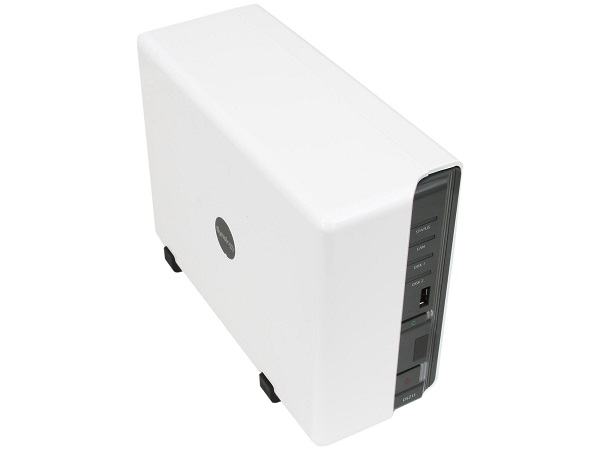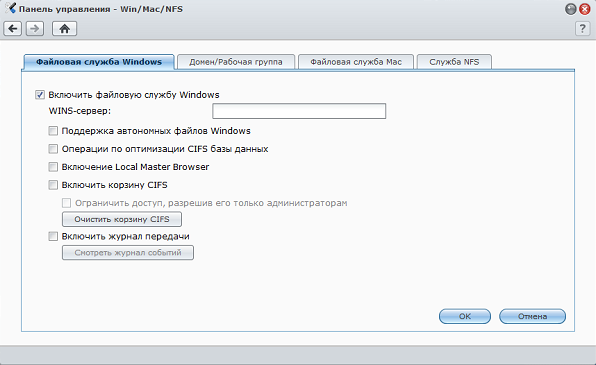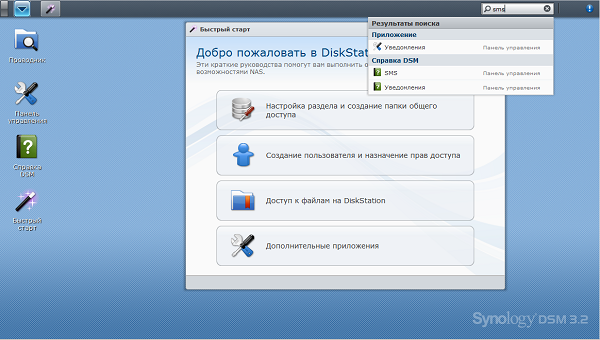Synology DiskStation 211j Review
For a long time, I had a regular system unit in my pantry, inside of which is installed an old seleron, 128 megabytes of RAM, a system hard disk of 70 gigabytes in size and a mirrored array of two terabyte disks.
This system is my home server. I keep there a home collection of photos and videos, important backups, I am developing a web development (this is the type of home dev server) and a hosch web interface for viewing photos to show them to parents who live in another city. In addition, he streams music and videos to all my setboxes, iPads, iPhones and androids at home.
This all works under control of Ubuntu 11.10
')
I must say that this thing takes up a lot of space and makes a lot of noise, but it cost me about 20,000 r. three years ago.
This is a NAS (network storage information) with a wealth of additional functionality. But about him later.

The DS211j has a 1.2-gigahertz Marvell Kirkwood MV6281 processor, 128 megabytes of DDR2 RAM, and supports up to two 3-terabyte disks (3 "5 2" 5 inches) in the RAID in the following configurations: plain JBOD, RAID-0 or RAID-1. The device also supports iSCSI. There is no internal permanent memory in the device, so after the purchase and installation of disks, initial configuration and installation of the OS will be required. Fortunately, for this there is DiskStation Assistant, which with the help of a wizard will help you quickly complete this procedure: select the type of raid array and configure the basic storage settings. In my case, there are two 250 gigabyte disks in the test device and I made a mirror of them (RAID-1). The idea of the lack of its own permanent memory is good on the one hand The OS developers for the device are not very limited in size, so they can easily extend the functionality. On the other hand, I can’t insert two of my disks from the old system in the repository so that I don’t do anything with them. We'll have to transfer information somewhere, reconfigure the raid, and then pour everything into the repository.
The storage has an active cooling system that primarily blows through hard drives. A 70 mm fan is used to blow through (quiet enough to sleep in one room with it).
In terms of power consumption, with appropriate settings, the device is extremely economical: hard drives can fall asleep with prolonged non-use, and also, you can configure the on and off by timer. For example, to correlate the time with office hours.
From the point of view of iron, storage is done perfectly. The case is elegantly disassembled to insert or change discs. There are two screws for fasteners, but it is not necessary to tighten them, as the case is held without them.

On the case there are 3 USB 2.0 connectors and one gigabit Ethernet. USB can be used to connect external drives and flash drives. External drives are mounted automatically and become available in the form of network folders named usbshare1-3.

If you for some reason do not want to connect the device with a wire, then you can insert a WiFi adapter into the USB port. The Linux kernel version is 2.6.32.12, which guarantees the support of a sufficiently large number of wireless adapters.
You can also use the storage as a Print Server, simply by connecting a printer to it via the same USB.
Above all, the storage supports IP cameras. About this, too, a little later.
Here, of course, my vault evokes mixed feelings.
Very cool is the fact that the developers approached the software complexly. It was a pleasant surprise to discover that DiskStation is able not only to store information, but also to distribute it well to different worlds. There are applications for iOS and Android that allow you to watch photos and videos, listen to music, connect to webcams, view files, download files, torrents, edk-distributions. The storage can work as an FTP / SMB / Windows Share server, as well as a UPnP / DLNA. Apple iTunes Server is also supported. In fact, DiskStation can be your home cloud. Do not forget about the print server, although most printers today are able to connect to the network directly.
This is what causes confusion. The paradigm of the user to whom this device will be extremely useful goes against the paradigm of the operating system / shell of the device itself. It can be seen that the DSM in the current version 3.2 worked long and carefully. But in the end we got a web interface over Linux. It's not that bad, just the appearance of icons, windows and menus does not solve the main problem: NOTHING IS CLEAR!

The user is surrounded by all those same incomprehensible terms, nothing to him to say abbreviations, ports, addresses, and other devilry. All useful services such as photo, video and audio stations (the so-called services in the DiskStation) are initially turned off.
Here is the configuration of network folders attacked the user with some terrible terms and abbreviations:

On the other hand, there is the so-called “Quick Start”, which for review is just a small story about the functionality of the system and a collection of shortcuts for the main services of the repository. You can also enter a keyword in the search and get into either the desired management interface or help.

But do not be discouraged! It turns out the repository has a mobile version of the web interface, which is much friendlier:

It allows you to simply turn on and off services, manage users, monitor the status of the device, and even has the function “Find me!”. When it is turned on, the device starts beeping. This is probably useful when you have drunk your device or have short-term memory lapses. But seriously, it is most likely very convenient if you have a cluster of such pieces of hardware.
I can say that, unlike a large interface, it is a pleasure to control the device through a mobile device.
I would say this: you can use the main interface only if you are a system administrator. Mobile can be used by anyone.
As an example of a successful solution, I will show the interface for working with video surveillance:

DiskStation 211 is a very sophisticated and well-designed storage. This is a product of a full cycle, that is, not only a box for disks, but a whole infrastructure of management interfaces, applications for different platforms and usage scenarios. Unfortunately during the development engineers prevailed over the designers and as a result the device is frightening with its adaptability. Designers could hide all this WINS / SMB / NFS UPnP behind the criteria that the mortal user understands: music, files, folders, photos, OS backups, and more. 2011 is the same.
Nevertheless, a huge leap is still noticeable in relation to the operator, management becomes friendlier. I would look forward to DSM 4, in which everything will be immediately turned on and everything will work without tuning.
For me personally, one more minus is that it is impossible to insert an existing raid array into the storage.
The undoubted advantage is the quality of work. To the repository, quietly distributes a video of 720x480 to two Androids, one iPad and two Ixtrimers. All files are different and distribution goes simultaneously through UPnP, SMB and iTunes. This is only at 1.2 gigahertz and 128 megabytes of RAM.
I believe that the DiskStation line from Synology is very promising products with rich functionality, and if you continue to work on the design of the management interface, it will already be a product from the category of Mast-hev.
Speck Synology DS211j
DSM 3.2 operating shell
Russian site Synology
This system is my home server. I keep there a home collection of photos and videos, important backups, I am developing a web development (this is the type of home dev server) and a hosch web interface for viewing photos to show them to parents who live in another city. In addition, he streams music and videos to all my setboxes, iPads, iPhones and androids at home.
This all works under control of Ubuntu 11.10
')
I must say that this thing takes up a lot of space and makes a lot of noise, but it cost me about 20,000 r. three years ago.
This is a NAS (network storage information) with a wealth of additional functionality. But about him later.

Iron
The DS211j has a 1.2-gigahertz Marvell Kirkwood MV6281 processor, 128 megabytes of DDR2 RAM, and supports up to two 3-terabyte disks (3 "5 2" 5 inches) in the RAID in the following configurations: plain JBOD, RAID-0 or RAID-1. The device also supports iSCSI. There is no internal permanent memory in the device, so after the purchase and installation of disks, initial configuration and installation of the OS will be required. Fortunately, for this there is DiskStation Assistant, which with the help of a wizard will help you quickly complete this procedure: select the type of raid array and configure the basic storage settings. In my case, there are two 250 gigabyte disks in the test device and I made a mirror of them (RAID-1). The idea of the lack of its own permanent memory is good on the one hand The OS developers for the device are not very limited in size, so they can easily extend the functionality. On the other hand, I can’t insert two of my disks from the old system in the repository so that I don’t do anything with them. We'll have to transfer information somewhere, reconfigure the raid, and then pour everything into the repository.
The storage has an active cooling system that primarily blows through hard drives. A 70 mm fan is used to blow through (quiet enough to sleep in one room with it).
In terms of power consumption, with appropriate settings, the device is extremely economical: hard drives can fall asleep with prolonged non-use, and also, you can configure the on and off by timer. For example, to correlate the time with office hours.
From the point of view of iron, storage is done perfectly. The case is elegantly disassembled to insert or change discs. There are two screws for fasteners, but it is not necessary to tighten them, as the case is held without them.

Periphery
On the case there are 3 USB 2.0 connectors and one gigabit Ethernet. USB can be used to connect external drives and flash drives. External drives are mounted automatically and become available in the form of network folders named usbshare1-3.

If you for some reason do not want to connect the device with a wire, then you can insert a WiFi adapter into the USB port. The Linux kernel version is 2.6.32.12, which guarantees the support of a sufficiently large number of wireless adapters.
You can also use the storage as a Print Server, simply by connecting a printer to it via the same USB.
Above all, the storage supports IP cameras. About this, too, a little later.
Operating system and software
Here, of course, my vault evokes mixed feelings.
Very cool is the fact that the developers approached the software complexly. It was a pleasant surprise to discover that DiskStation is able not only to store information, but also to distribute it well to different worlds. There are applications for iOS and Android that allow you to watch photos and videos, listen to music, connect to webcams, view files, download files, torrents, edk-distributions. The storage can work as an FTP / SMB / Windows Share server, as well as a UPnP / DLNA. Apple iTunes Server is also supported. In fact, DiskStation can be your home cloud. Do not forget about the print server, although most printers today are able to connect to the network directly.
This is what causes confusion. The paradigm of the user to whom this device will be extremely useful goes against the paradigm of the operating system / shell of the device itself. It can be seen that the DSM in the current version 3.2 worked long and carefully. But in the end we got a web interface over Linux. It's not that bad, just the appearance of icons, windows and menus does not solve the main problem: NOTHING IS CLEAR!

The user is surrounded by all those same incomprehensible terms, nothing to him to say abbreviations, ports, addresses, and other devilry. All useful services such as photo, video and audio stations (the so-called services in the DiskStation) are initially turned off.
Here is the configuration of network folders attacked the user with some terrible terms and abbreviations:

On the other hand, there is the so-called “Quick Start”, which for review is just a small story about the functionality of the system and a collection of shortcuts for the main services of the repository. You can also enter a keyword in the search and get into either the desired management interface or help.

But do not be discouraged! It turns out the repository has a mobile version of the web interface, which is much friendlier:

It allows you to simply turn on and off services, manage users, monitor the status of the device, and even has the function “Find me!”. When it is turned on, the device starts beeping. This is probably useful when you have drunk your device or have short-term memory lapses. But seriously, it is most likely very convenient if you have a cluster of such pieces of hardware.
I can say that, unlike a large interface, it is a pleasure to control the device through a mobile device.
I would say this: you can use the main interface only if you are a system administrator. Mobile can be used by anyone.
As an example of a successful solution, I will show the interface for working with video surveillance:

Summarize
DiskStation 211 is a very sophisticated and well-designed storage. This is a product of a full cycle, that is, not only a box for disks, but a whole infrastructure of management interfaces, applications for different platforms and usage scenarios. Unfortunately during the development engineers prevailed over the designers and as a result the device is frightening with its adaptability. Designers could hide all this WINS / SMB / NFS UPnP behind the criteria that the mortal user understands: music, files, folders, photos, OS backups, and more. 2011 is the same.
Nevertheless, a huge leap is still noticeable in relation to the operator, management becomes friendlier. I would look forward to DSM 4, in which everything will be immediately turned on and everything will work without tuning.
For me personally, one more minus is that it is impossible to insert an existing raid array into the storage.
The undoubted advantage is the quality of work. To the repository, quietly distributes a video of 720x480 to two Androids, one iPad and two Ixtrimers. All files are different and distribution goes simultaneously through UPnP, SMB and iTunes. This is only at 1.2 gigahertz and 128 megabytes of RAM.
I believe that the DiskStation line from Synology is very promising products with rich functionality, and if you continue to work on the design of the management interface, it will already be a product from the category of Mast-hev.
Additional links
Speck Synology DS211j
DSM 3.2 operating shell
Russian site Synology
Source: https://habr.com/ru/post/132023/
All Articles